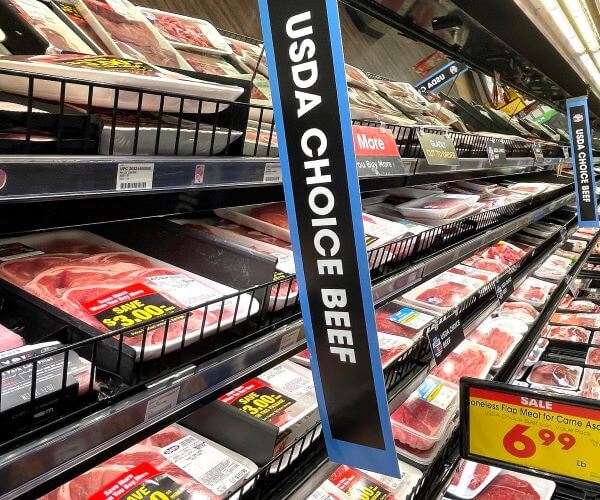
Americans Still Reeling From Higher Prices Even as Inflation Slows
- Economy
- March 15, 2024
- No Comment
- 157
Inflation’s salience with voters ranks well behind immigration and the general state of the economy — but ahead of foreign policy, climate, taxes, healthcare and crime, according to the latest poll for The Wall Street Journal.
Most voters disapprove strongly (50%) or somewhat (10%) of President Joe Biden’s handling of inflation, based on a nationwide survey of more than 1,700 registered voters conducted in late February.
The poll is picking up consumer frustration with the very large and unexpected rise in prices during the pandemic and its aftermath, even if the rate of further increases has now slowed.
Similar political tensions are evident in most of the other advanced economies as consumers struggle with the legacy of sharply increased prices during and after the pandemic.
In Europe, the problem has been compounded by the sharp rise in retail gas and electricity prices after Russia’s invasion of Ukraine and the sanctions imposed in response.
Persistent inflation, especially in services, has made the Federal Reserve cautious about cutting interest rates to help the U.S. economy accelerate after the business cycle slowdown in 2022/23.
Prices rose by 2.4% over the 12 months ending in January 2024, according to the U.S. price index for personal consumption expenditures (PCE), the inflation measure favored by the central bank.
PCE inflation had slowed from a post-pandemic high of 7.1% in June 2022 and was not far above the central bank’s long-term flexible average inflation target of 2.0%.
But price increases for merchandise have slowed much more sharply than for services, creating a dilemma for the Fed, which must set interest rates for the whole economy.
Prices for goods fell 0.5% over the 12 months ending in January 2024, after increasing 10.6% in the 12 months to June 2022, the fastest rise for more than 40 years.
By contrast, services prices continued to increase by 3.9% in the year to January 2024, though the rate of increase had slowed somewhat from a peak of 6.0% in the year to February 2023.
DIVERGING INFLATION
Energy and raw materials make up a much larger share of costs for manufacturing businesses, which also rely more heavily on international supply chains and are more exposed to foreign competition.
The pandemic and its aftermath had its biggest and most immediate impact on manufacturers owing to the sudden rotation of spending to merchandise from services and the simultaneous disruption of global supply chains.
But as prices of energy and other raw materials have stabilized, supply chains normalized and spending rotated back to services, merchandise prices steadied and have remained basically flat since the middle of 2022.
By contrast, service sector firms use much less energy and are less exposed to international supply chains and competition from abroad, but are much more labor-intensive.
The rotation back towards services, coupled with rising wages and lack of foreign competition has fueled faster increases in services prices.
Persistent inflation in the much-larger and more labor-intensive services sector is too important for the central bank to ignore.
Services account for almost two-thirds of household spending (roughly one-third on housing, one-third on other services) with merchandise responsible for the rest.
Service sector firms employ far more people (110 million) than manufacturers (13 million) and construction businesses (8 million).
Service sector production ($16 trillion) is almost double that for goods ($9 trillion) and far above construction ($2 trillion).
DIVERGING PRICE LEVELS
While the rate of increase in prices has slowed, the upsurge during and after the pandemic has left the overall level of prices much higher than anticipated at the start of 2020.
Based on the PCE price index, overall prices were about 10% higher in January 2024 than they would have been if they continued increasing on the same trajectory that prevailed for the 10 years before January 2020.
The sudden escalation in the price level compared with what most households expected as “normal” before the pandemic explains why so many consumers express sticker shock and vent their unhappiness in opinion polls.
For many households, wages and other income have also risen since January 2020, in some cases sharply, but the increase has been uneven, which helps explain why the rise in the price level has become politically sensitive.
Explaining that prices are no longer rising fast is not much comfort to those voters whose incomes have already fallen behind the increase in the price level since the pandemic began.
Moreover, while goods prices have stabilized since the middle of 2022, they have done so much further above trend than for services.
Goods prices are about 14% above the pre-pandemic trend, with durable goods prices as much as 18% above trend, despite some recent discounting.
By contrast, services prices are only about 8% above trend and prices excluding housing and energy are only 7% above trend.
PLAYING CATCH UP
Some of the continued increase in service prices during 2023 and 2024 likely represents an attempt to catch up with the higher price level in manufacturing after big increases between mid-2020 and mid-2022.
For policymakers, the nightmare scenario is if services firms try to restore their prices relative to manufacturers, and workers whose incomes have fallen relative to inflation try to restore them to pre-pandemic levels.
Efforts to restore real prices and wages to the prior trend were one of the key drivers of persistent inflation in the 1970s and early 1980s.
The institutional context is very different in the 2020s, with weaker labor unions and less collective bargaining over wage rates.
But central banks in all the major economies are on high alert for any signs of catching-up price and wage rises that could fuel a second round of inflation.
Prolonged weakness in production and the stabilization of prices in the manufacturing sector arguably create a case for lower interest rates to stimulate more purchases of expensive durable items.
But service sector resilience and continued price rises by services firms make aggressive interest rate reductions risky in case they cause service sector inflation to accelerate again.
John Kemp is a Reuters market analyst. The views expressed are his own.
© 2024 Thomson/Reuters. All rights reserved.
#Americans #Reeling #Higher #Prices #Inflation #Slows









